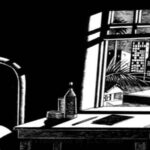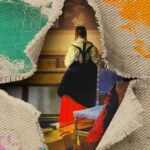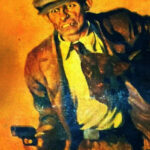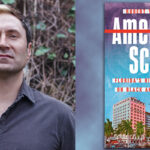On Hope, Resilience, and Denial in the Great State of California
"The inheritance of California is half-gorgeous, half-deadly."
When Elizabeth and I weren’t shuttling baskets of fries and feeding tourists a fake age, fake name, fake history, we fled Swall Meadows and drove to Bishop in her Oldsmobile and sat in pink vinyl booths in an ice cream parlor until it shut down. In Kmart I pushed her around in a shopping cart filled with pillows while she brandished a fishing net at shoppers. Outside in the parking lot we chased a piece of cottonwood fluff struck white by floodlights against a dark sky. We gazed up until our necks hurt.
We stood on Main and watched traffic chug, watched trucks hauling hay from Nevada, and considered leaping onto the bails at a red light so we, too, could ride away—our one wish in those days, to go away—certain, without proof, that away was better.
Los Angeles waited. The drawers of the history museum in Owens Valley are filled with folders on bats and mules and barbed wire, but there are no universities in our county and not many jobs. My high school class, numbering fifty, scattered after graduation. The mountains that had cradled us in childhood conjured loneliness, hiding whatever lay beyond.
We were born sutured to the city. And so I turned 18 and quit my job at the greasy spoon, went to Kmart and bought myself a red bath towel and a little wire caddy for the showers in the dorm, and packed my old bedroom into the back of Pop’s map delivery van.
“Make Your Mind Up to Wind Up in Sunny California” was a ragtime song popular in 1930. On March 15 of the same year, a tornado struck near downtown Los Angeles. “The wind became playful,” the Examiner reported. “It scooped up many rabbits and chickens and carried them out of the town.” Later “glass flew like paper through the streets, more chickens and rabbits were caught in the funnel, and roofs were torn from hundreds of homes.” The tornado lifted a freight train from the tracks and threw it against a barn. Walls and porches were “torn off and shot like arrows across space.” The twister whisked away garages, then hoisted a house and set it down in the street while “several persons were picked up bodily and hurled a distance of fifty to one hundred feet.”
A half century later the LA area experienced two tornadoes, mudslides, and an earthquake more or less simultaneously. The tornadoes wrecked more than 120 buildings and made so much noise Angelenos feared a plane crash or an atomic bomb. In close to a century LA tornadoes have destroyed about 60 major buildings, damaged around 15 hundred houses and businesses, and wounded close to two hundred people.
A “tornado alley” exists in downtown Los Angeles, a result of the meeting of cold air, a curved coast, and mountains.
The inheritance of California is half-gorgeous, half-deadly. It is half-remembered and half-lost.Here, tornadoes strike with a frequency comparable to the Midwest. Los Angeles is not proud of its wild side. An 1876 poster heralds California as the “Cornucopia of the World,” the words printed over a tumble of grapes, bananas, and pineapples. “Private Land for a Million Farmers,” the poster declares. “A Climate for Health and Wealth without Cyclones or Blizzards.” An F2 tornado struck Pasadena late in January 1918, shredding streets and walloping a woman in the back with a rafter. The next day the Times and Examiner were scheduled to publish booster editions coinciding with blizzards elsewhere. “Big Drifts Bury East,” the Times warned. “Come to California, land of beauty, flowers, and sunshine . . . Southland’s arms are outstretched in cordial invitation to the East!”
The papers did not report on the tornado that destroyed two churches and uprooted a grove of orange trees. Instead the Times referred to the “tail end of a wind storm” that entertained Angelenos by “playfully picking up stray pieces of paper.” Many folks in neighboring parts of the city never knew the tempest occurred.
To forget the past, writes the Californian Rebecca Solnit, is to forgo your sense of loss, and at the same time to lose “a set of clues to navigate the present by.” The void that was suddenly my home screamed to be muffled by noise. Where else to go but the city to the south, poster child of California, shielded from the world’s dangers by denial? How easy it is, when faced with eternal night, to run toward neon and a billboard sun. Historian Kevin Starr describes the galvanizing feature of early California, gold rush California, as a “psychology of expectation.” Room enough, Mary Austin tells us, and time enough in these desert hills. But Los Angeles offered more than room and time—it beckoned with the promise and dreams of a certain kind of future, bright and untainted by the past.
Our state could easily contain ten European countries. It has redwoods and fog and snow, dolphins and pine martens and antelope. It has libertarians and hippies. It is a home to immigrants from everywhere. Yet all its many pieces share this in common: ours is a state thus far defined by growth. Growth demands optimism. At its best, optimism demands resilience. At its worst, optimism demands forgetfulness. And these can be difficult to distinguish.
Where did my brother, snatched from tragedy, learn to hoist himself from the pavement after that crash on the skateboard, half-crushed by Pop and smiling? Where but from his father, who came from a long line of indestructibles? Is my father’s family resilient or just forgetful? Are we forever hopeful, or have we failed to learn the lessons of the past? All I can say for sure is that California seemed built for the Atlees. Nana marched with Mothers for Peace and Beyond War, then sat at the kitchen table, her hair a white halo, and informed us that all men suffered from castration anxiety. She believed the word fuck should be reclaimed, she told all the neighbors, “because sex isn’t dirty!” and she mortified Fafa by announcing, at a dinner with my aunt’s family, her plan to write a book called Sex after Seventy.
“Fafa smacked the table,” my cousin told me, “looked at her in horror, and said, ‘Susan!’”
My father’s earliest memory involves a plastic fire truck with a little hose, given to him by his parents, and a milk carton with cutout windows. Nana lit the milk carton on fire and shrieked “Save us! Save us!” while her toddler son put out the flames. At four, my father’s sister treed herself at the top of a telephone pole. Later, with Nana’s permission, she threw a bag of rocks over a cow’s back to tame her for riding. At three, Pop crashed off his parents’ California king bed and broke his collarbone. He broke the same collarbone 50 years later crashing his motorcycle and then again crashing on his skis.
Pop’s optimism grew strongest when he found an exciting way to risk death. Years ago another wildfire approached Swall, the first time I saw planes dropping red powder. Mom drove home from work past a wall of flame, and all day we cleared brush away from trees and filled buckets with water. After dark, when the sheriff came around to tell everyone to evacuate, Pop wanted me to stay, to help him fight the fire. He said if we had to we could climb into the neighbor’s pond and pull sheet metal over our heads. Or we could ride his motorcycle, me clinging to his back, and accelerate through the flames. I was 12 years old. Mom said absolutely not. He stayed by himself, patrolling with a garden hose. When I remind him of that night, Pop chuckles gleefully. “We could have gotten out of there. You’d have been fine!”
Even our animals seemed wild optimists, guided by mad instinct. The black tom, Mirage, from whose long coat Mom cut snarls, peed on Pop’s ski equipment in the garage, vying for territory and persisting even after Pop plopped Mirage down in the shower and peed on him. Mirage loved Mom with dog-like devotion and mewed to her in a high, frail voice. When Pop dropped him off on a ranch half-way to Bishop—to be a mouser, he said—Mirage walked ten miles home.
Not much of moderation, nor a barometer for normal, in the indestructible Atlee family. In a letter to Nana, Mom wrote:
Kendra just came to visit me. She came to get me to walk her outside because she was frightened. She said, “Mom! Don’t you remember when you were four and your father brought home the skull of a dead horse that had teeth and hair and put it right by the door? Remember how you were afraid to walk by it?”
Really, that wasn’t one of my memories, but then I didn’t have Robert as a father—and there is a horse skull by our front door.
*
Mom was born in the darkest days of the year and raised in the deep woods of Michigan. But she married a man born in a dry summer on a golden coast, and she fledged her family in California. Once, our limbs were strong and our lungs swelled with the thin air of high altitude. The sun shone over our heads three hundred days a year. For all our knowledge of rescue and caution, we were gilded. What an insult to be, abruptly, not only breakable but broken. From my home I learned to live afflicted half with the care of the pilot who hopes to grow old, half with the impulse to fling myself into the future headlong, hands scrabbling for purchase on a shifty mountainside and never mind the past. How I ran with that plastic airplane tottering behind me on its string. How we flew from the trapeze in our living room.
Nana and Fafa came to California for a honeymoon in 1951 and stayed the rest of their lives. They discovered the state during a postwar boom, after the weird chaos of the gold rush and the devastation of First Peoples and the battles that led to statehood had saturated “the alkaline dirt we call California,” as Richard Rodriguez puts it, a time when a bunch of land developers and entertainment types and people from somewhere else built industries on the quicksand of history. There’s more than one kind of gold to be yanked out of the ground in California. Richard Rodriguez is the child of Mexican immigrants and he writes of the ballooning Sacramento of his 1950s boyhood, of “freeways and new cities, bright plastic pennants and spinning whirligigs announcing a subdivision of houses; hundreds of houses; houses where there used to be fields.”
“Better make your next location California!” went the 1930 ragtime hit. At times in the 1960s, California’s population grew by 1,500 in a single day. How strange Rodriguez’s California, the winter warmth, the press of the grinning crowd, must have seemed to Nana and Fafa for a while—the lax dress, the willingness to bare skin, against a backdrop of rabid growth. They had the prudent East for comparison, just as Rodriguez saw his Mexican parents—and the Irish Catholic nuns who taught him how to write—looking back at their history, seeing tragedy behind and tragedy ahead.
The inheritance of California is half-gorgeous, half-deadly. It is half-remembered and half-lost. It is a brother with a past like a time bomb—but let’s not worry about that now. “Look to the future,” Joan Didion instructs her compatriots. “The future always looks good in the golden land, because no one remembers the past.”
My father has a friend who spent enough years beneath the high Sierra sun that his nose was cut off to save his face. The rubber prosthesis hurts to wear. He greets us and we see the crater, the wet cave. Still, the sun shines; we bask and forget what it can do in this place free from rust and too dry for decay.
If optimism means forgetfulness, then our optimism was necessary for a certain kind of future to occur, for growth, a certain version of the greatest good. California was home to one of the most effective advertising campaigns in history, converting not only new customers but those who had already bought the product. Remembering winter free of storms was essential to what historians call the growth machine: the developers, politicians, journalists, and newspaper owners who boosted California and in the process turned an ideal into culture. The blood of our valley supplied the state’s racing heart.
In Inyo County, 18,000 people populate 10,000 square miles. Spread us out and you get fewer than two people per mile—we could wave to our neighbors in the distance, over mirage. Greater Los Angeles fits over 13 million into an area half as large—that’s about 2,600 people per square mile. You might imagine a city where the sky hangs an infected yellow-green. Buildings cluster like bad molars. Searchlights shoot down the stars.
But I could see, for the first time, the ugliness of home, invasive tumbleweed and cheatgrass and the busted signs on Main. Fishing line snarled around lakeshores. Dead deer heaped along the highway. If country once so full could become so empty, why stay?
“Fences have been strung across these roads,” a woman wrote in the local paper in the early 1930s while Owens Valley hemorrhaged. “Signs have been posted announcing, ‘Road Closed,’ and this is the answer to the question, ‘Will you come back?’”
When the water left Owens Valley, Austin recorded, “Mary did what she could. And that was too little. The year before she had built a house—the brown house under the willow tree. She walked in the fields and considered what could be done. She called upon the Voice, and the Voice answered her—Nothing. She was told to go away.”
When the eye drifts off the sparrow, when the world feels unattended, when beauty drains like water flowing south—you throw beer cans out the window. You fly away. The Owens Valley woman who watched the towns slump answered her own question: “No, you won’t come back. The road is closed and the fence is up. Anyway, why concern yourself any longer with the inevitable? Fill up the radiator, pour in the gas and step on it.”
__________________________________
From Miracle Country by Kendra Atleework. Reprinted with the permission of the publisher, Algonquin Books. Copyright © 2020 by Kendra Atleework.




















